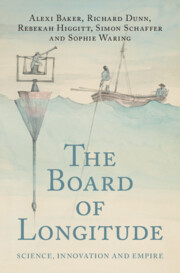Book contents
- The Board of Longitude
- The Board of Longitude
- Copyright page
- Dedication
- Contents
- Figures
- Tables
- Boxes
- Acknowledgements
- Timeline
- Abbreviations
- 1 Introduction
- 2 Sailing the Oceans and Seeking Longitude before 1714
- 3 Launching the Eighteenth-Century Search for Longitude
- 4 The Early Commissioners in Transition
- 5 The Birth of the Board of Longitude
- 6 Time Trials
- 7 Manufacturing the Nautical Almanac
- 8 Managing, Communicating and Judging Longitude after Harrison, 1774–c. 1800
- 9 A Practical Institution Weighed Down by Impractical Proposals?
- 10 What Is an Observatory? From the Metropolis to the Cape
- 11 The Death and Rebirth of the Board of Longitude
- Epilogue
- Book part
- Glossary
- Bibliography
- Index
3 - Launching the Eighteenth-Century Search for Longitude
Published online by Cambridge University Press: 11 April 2025
- The Board of Longitude
- The Board of Longitude
- Copyright page
- Dedication
- Contents
- Figures
- Tables
- Boxes
- Acknowledgements
- Timeline
- Abbreviations
- 1 Introduction
- 2 Sailing the Oceans and Seeking Longitude before 1714
- 3 Launching the Eighteenth-Century Search for Longitude
- 4 The Early Commissioners in Transition
- 5 The Birth of the Board of Longitude
- 6 Time Trials
- 7 Manufacturing the Nautical Almanac
- 8 Managing, Communicating and Judging Longitude after Harrison, 1774–c. 1800
- 9 A Practical Institution Weighed Down by Impractical Proposals?
- 10 What Is an Observatory? From the Metropolis to the Cape
- 11 The Death and Rebirth of the Board of Longitude
- Epilogue
- Book part
- Glossary
- Bibliography
- Index
Summary
This chapter scrutinises the British Longitude Act of 1714 and its immediate aftermath. It shows, first, the extent to which the wording of the Act drew on precedents from the previous century. Second, it argues that the Act was never intended to create a ‘Board of Longitude’ as a formal, standing committee with regular meetings. Rather, it nominated a number of individuals – by name or by virtue of their official role – seen fit to judge potential ideas. This is a powerful example of the way in which longitude legislation was revisable and open-ended. With this in mind, the chapter shows that the Act did indeed foster considerable activity and discussion around longitude matters over the next two decades. This activity was marked by considerable continuity in the persistence of schemes already being discussed before 1714: eclipses, lunar distances, artificial timekeepers, magnetic variation and dip, signalling, and dead reckoning.
Keywords
- Type
- Chapter
- Information
- The Board of LongitudeScience, Innovation and Empire, pp. 39 - 64Publisher: Cambridge University PressPrint publication year: 2025

